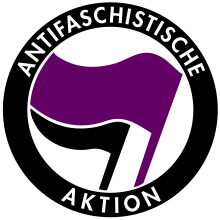| Part of a series on |
| Anti-fascism |
|---|
 |
| Part of a series on |
| Feminism |
|---|
 |
|
|

Fantifa (sometimes rendered as f_antifa[1] or f*antifa;[2] a contraction of German Feministische Antifa, lit. feminist anti-fascism, or Frauen Antifa, lit. women's anti-fascism) is an umbrella term for anti-fascism movements centering on women as a branch of the feminist movement. The term mostly refers to a formal movement of feminist anti-fascist groups that emerged from German-speaking countries in 1985 but also encompasses historical German groups such as the 1925 Rote Frauen und Mädelbund (the women and girls' branch of the Roter Frontkämpferbund) and broader European groups such as the 1930s Spanish anarcha-feminist group Mujeres Libres, the 1934 French women's branch of the World Committee Against War and Fascism, and the 1942 Yugoslavian partisan group Women's Antifascist Front of Yugoslavia.[3]: 5 The main fantifa movement holds an anarcho-communist philosophy and is specifically an anti-fascist variant of anarcha-feminism, as is sometimes represented in the use of a purple and black flag with a symbol derivative of that of the men's antifa group Antifaschistische Aktion.
- ^ "10.02. Alles F_Antifa? Zur feministischen Perspektive von Antifa". Antifa Café Dortmund. 2022-02-10. Retrieved 2023-01-15.
- ^ "Ein Plädoyer für die F*antifa". Antifaschistisches Info Blatt. 2017-02-01. Retrieved 2023-01-15.
- ^ Fantifa: Feministische Perspektiven Antifascisischer Politik. Münster, North Rhine-Westphalia: Edition Assemblage. 2013. ISBN 978-3-942885-30-0.
© MMXXIII Rich X Search. We shall prevail. All rights reserved. Rich X Search
